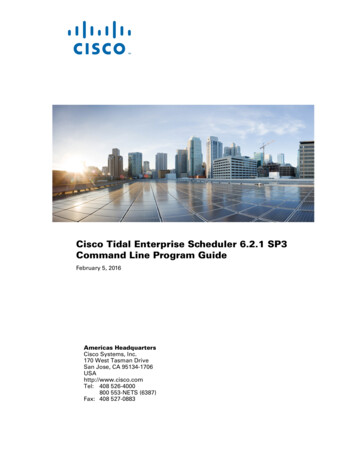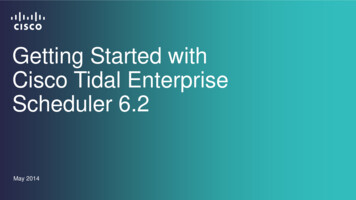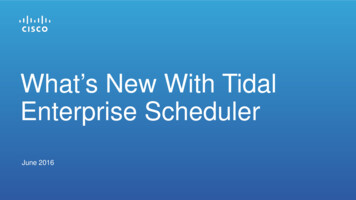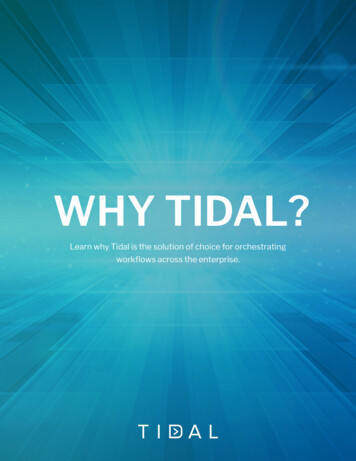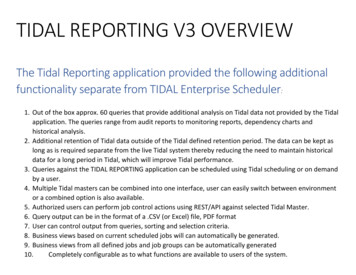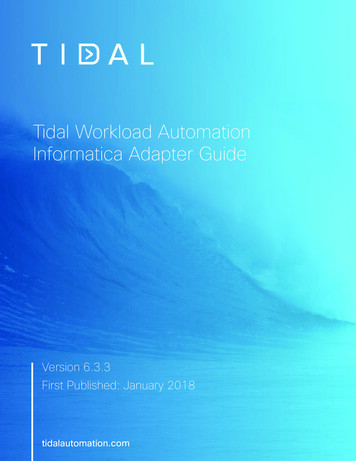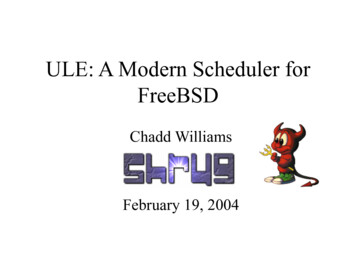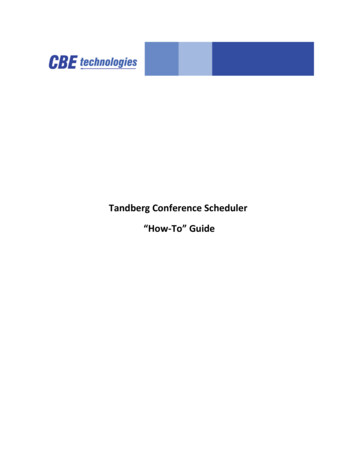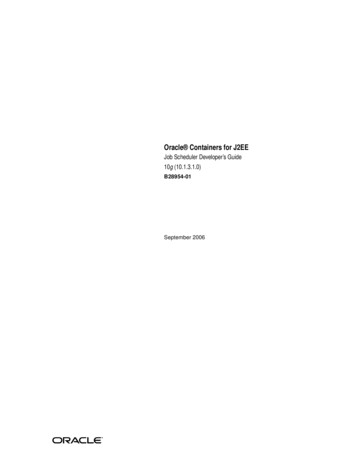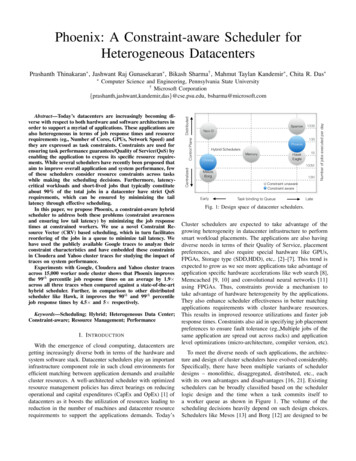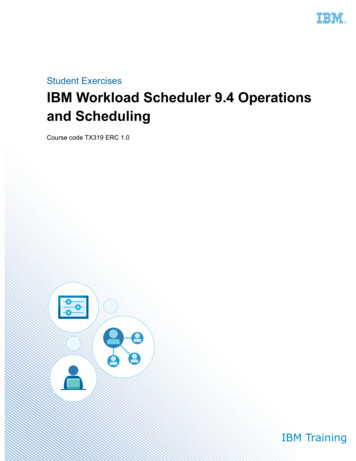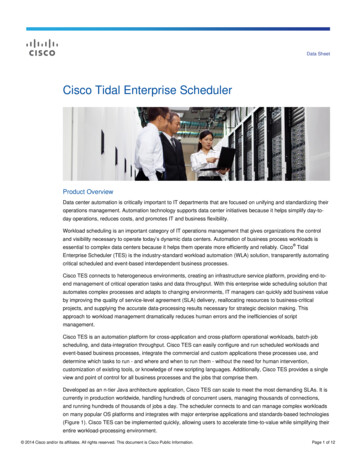
Transcription
Data SheetCisco Tidal Enterprise SchedulerProduct OverviewData center automation is critically important to IT departments that are focused on unifying and standardizing theiroperations management. Automation technology supports data center initiatives because it helps simplify day-today operations, reduces costs, and promotes IT and business flexibility.Workload scheduling is an important category of IT operations management that gives organizations the controland visibility necessary to operate today’s dynamic data centers. Automation of business process workloads isessential to complex data centers because it helps them operate more efficiently and reliably. Cisco TidalEnterprise Scheduler (TES) is the industry-standard workload automation (WLA) solution, transparently automatingcritical scheduled and event-based interdependent business processes.Cisco TES connects to heterogeneous environments, creating an infrastructure service platform, providing end-toend management of critical operation tasks and data throughput. With this enterprise wide scheduling solution thatautomates complex processes and adapts to changing environments, IT managers can quickly add business valueby improving the quality of service-level agreement (SLA) delivery, reallocating resources to business-criticalprojects, and supplying the accurate data-processing results necessary for strategic decision making. Thisapproach to workload management dramatically reduces human errors and the inefficiencies of scriptmanagement.Cisco TES is an automation platform for cross-application and cross-platform operational workloads, batch-jobscheduling, and data-integration throughput. Cisco TES can easily configure and run scheduled workloads andevent-based business processes, integrate the commercial and custom applications these processes use, anddetermine which tasks to run - and where and when to run them - without the need for human intervention,customization of existing tools, or knowledge of new scripting languages. Additionally, Cisco TES provides a singleview and point of control for all business processes and the jobs that comprise them.Developed as an n-tier Java architecture application, Cisco TES can scale to meet the most demanding SLAs. It iscurrently in production worldwide, handling hundreds of concurrent users, managing thousands of connections,and running hundreds of thousands of jobs a day. The scheduler connects to and can manage complex workloadson many popular OS platforms and integrates with major enterprise applications and standards-based technologies(Figure 1). Cisco TES can be implemented quickly, allowing users to accelerate time-to-value while simplifying theirentire workload-processing environment. 2014 Cisco and/or its affiliates. All rights reserved. This document is Cisco Public Information.Page 1 of 12
Figure 1.Support for Cross-Application and Cross-Platform Workload ManagementFeatures and BenefitsCisco TES offers a range of features that work together to meet IT’s needs for enterprise visibility, scalability, andcoverage and the daily creation and management of complex workload schedules.By automating complex workloads with Cisco TES, IT can positively affect SLA delivery in the following ways: Increase efficiency by simplifying batch processing across the distributed enterprise Enhance SLA reliability and reduce expensive downtime through workload analytics, alert automation, anda high-availability failover platform Improve competitive advantage by delivering error-free data processing Support a proactive mode of operation by complete workload visibility, predictive analytics, self-service jobimplementation, environmental awareness, and automated error remediation Improve comprehensive auditing and tracking information in support of compliance with IT policies andprocedures Improve IT staff productivity through web, mobile, and Java clients and customized self-service portalsExtensible and Scalable DesignCisco TES gives IT managers a global view of their enterprise workloads through a single-pane view, regardless ofhow many applications or systems are touched by the defined workload. Cisco TES accommodates multiple levelsof dependencies and complex groupings, making it possible to automate extremely complex job streams, whilescheduling them through a hierarchy of standard and custom-defined calendars and programmable events.Cisco TES uses a multitier architecture to provide a single solution that meets enterprise needs for performance,extensibility, and scalability. Separate architecture layers provide a stable, extensible framework, allowing it tohandle challenging workloads reliably. 2014 Cisco and/or its affiliates. All rights reserved. This document is Cisco Public Information.Page 2 of 12
The enterprise scheduler primary focuses primarily on the storage, management, and implementation of jobschedules. One or more client managers orchestrate user interactions. This n-tier architecture and the decouplingof core functions enable organizations to scale both up and out, allowing them to support a large number ofconcurrent users and jobs without degrading management or processing performance.Jobs and job streams are defined and managed through an intuitive GUI through which administrators can definethe many dependencies of enterprise business processes (Figure 2). Users can also access detailed performancestatistics for all jobs, past and present, and monitor processes as they occur. The scheduler supports real-timeevent and alert management, increasing uptime and SLA delivery levels.Cisco TES allows control of jobs and management functions from mobile devices. The Cisco TES mobile app letsyou manage adapter and agent connections and override, hold and stop, and release and resume jobs.Management functions also include the capability to filter and view jobs, alerts, events, schedules, connections,queues, and logs.Figure 2.Web Interface with Mobile Management: Single Point of Control for Enterprisewide Workload Automation 2014 Cisco and/or its affiliates. All rights reserved. This document is Cisco Public Information.Page 3 of 12
Enterprise Application and Database CoverageIn the heterogeneous and virtualized environments that characterize today's data centers, flexibility and reach arecritical. Cisco TES automates the scheduling of traditional enterprise applications, as well as complex, decoupled,and often widely distributed service-oriented architecture (SOA) applications, which frequently run on different OSplatforms.The enterprise scheduler integrates transparently with leading applications, such as SAP, Oracle, JD Edwards,PeopleSoft applications, and databases, such as Microsoft SQL Server and Oracle databases, using specificallydeveloped application adapters. Adapters for scheduling custom Java applications and web services connectionsextend the reach of the enterprise scheduler, offering detailed control and simplified access.The scheduler can also manage process integration through the use of agents running at the OS level. Cisco TESsupports many popular operating systems, including Microsoft Windows, UNIX, Linux, IBM z/OS, IBM OS/400, HPNonStop (NonStop Kernel [NSK]), and HP OpenVMS, and offers agentless adapters for Secure Shell (SSH) andMicrosoft Windows systems.Increasingly, businesses are using workload scheduling and batch-process automation technologies to integratethe business operations of their partners and customers. Cisco TES simplifies interenterprise data exchangethrough a powerful, script-free solution for file transfer, including FTP, SSH FTP (SFTP), and FTP SSL (FTPS).Database activities and process steps can also be automated in Microsoft, Oracle, or any Java databaseconnectivity (JDBC) - compliant database environment, with process steps even running on various enterprise datawarehouse appliances.Big Data and Business IntelligenceFrom data collection to storage, retrieval, analysis, and reporting, business processing depends on the capability tomove data between systems and applications both inside and outside your company. For many years, advances ininfrastructure and operations solutions kept pace with the growing amount of data. But with the accelerated growthof unstructured data such as voice, text, and video, traditional data analytics solutions have broken down. Today’schallenge is to accurately manage vast amounts of data, quickly moving it into and out of new big data processingapplications such as Hadoop.Cisco TES provides a comprehensive platform on which to manage business intelligence solutions and offersdetailed management of big data applications. Cisco TES offers a Hadoop adapter that allows detailed control overdata loading and flow management (Sqoop and Data Mover), Hadoop core data processing (MapReduce), and thedata interface layer (Hive) that allows input of SQL-like data query and analysis commands. The value of using theCisco Tidal Enterprise Adapter for Hadoop is that it allows you to define, schedule, and manage Hadoop jobs withmultiple layers of dependency mapping and nesting of parent and child jobs, drop-down parameter selections,highly specific alerts and automated job rerun functions, resource awareness for workload prioritization, andpredictive analytics to eliminate SLA delivery guesswork.The Cisco scheduler can define and run Data Mover jobs for MapR, Cloudera, and Apache Hadoop. Connect to aHadoop instance and define workloads as you would any other in your job stream. For all Cisco TES Hadoop jobs,the job tracker and task tracker process the jobs as they would any other Hadoop job, eliminating the overheadrequired to manage multiple schedulers, handle static scripts, and manually run complex workflows without thebenefit of audit trails or dependency mapping. 2014 Cisco and/or its affiliates. All rights reserved. This document is Cisco Public Information.Page 4 of 12
Cisco TES is also well suited to managing data integration (extract, transform, and load [ETL]), database, andenterprise data warehouse workloads and the report generation and delivery tasks that comprise integratedbusiness intelligence (BI) solutions. The scheduler supports IBM Cognos Business Intelligence, SAP BusinessInformation Warehouse (BW), SAP BusinessObjects, and Informatica out of the box with complex API integrationsfor each. Each interface has been carefully developed and tested to work transparently with each application.Combining these third-party application partnerships with Cisco’s WLA solution has the added benefit of providinga low-risk path to transition big data experimental projects from rogue IT to your process-based data center testand production environments.Management of Physical, Virtualized, and Cloud ResourcesAs information increasingly floods your data center and IT budgets and resources are tightened, managers andadministrators are seeking ways to control costs and to make the job of managing day-to-day operations easier.Cisco TES enables IT staff to define and schedule workloads in ways that adhere to strict infrastructure resourcesgovernance. Cisco TES allows for the prioritization of jobs, job groups, and entire business-critical workloads. Itcan also configure individual servers and processing resources to allocate the necessary resources to meet SLAson time. And if unplanned jobs are introduced or unforeseen environmental events arise, Cisco TES can adjustcapacity using its adapters for virtualized computing resources to manage public cloud processing and storageresources.IT is moving increasingly toward virtualization and decoupling of the core, OS, and application stacks, whetherinside the company firewall or outside in public cloud environments. Cisco TES is an excellent solution forautomating the management of these computing environments. The scheduler can automate the tasks performed by specific virtual machines within the firewall as well as manage Cisco Unified Computing System (Cisco UCS )servers, VMware instances, and Amazon Web Services (AWS) instances and storage buckets, and the datamovement in and out of these cloud resources.Cisco Tidal Enterprise Adapter for UCS Manager can bring up additional servers to meet workload bursts and shutthem down when high-need workloads are complete, reducing the burden on the infrastructure management teamto field requests for provisioning and decommissioning. Cisco TES can also help the infrastructure teams managescheduled server maintenance windows. Using Cisco TES agents, Cisco UCS customers can now build completeserver maintenance workflows and trigger them according to the maintenance window (calendar) defined in thescheduler.Cisco Tidal Enterprise Adapter for VMware makes it possible to perform a wide array of management tasks onhypervisors using the VMware vCenter server. You can power virtual machines on and off and suspend andresume their use, manage snapshots, adjust resources, and perform VMware vMotion activities. All these activitiescan take place as individual jobs or grouped workloads according to business process demand. This uniquecapability makes it possible for the state of a virtual environment to be balanced and optimized, helping guaranteeperformance and resource availability for essential business process steps.Cisco Tidal Enterprise Adapter for AWS gives you the capability to automate these public cloud resources.Managed Amazon Elastic Compute Cloud (EC2) resources include start, stop, and delete instances and AmazonMachine Images (AMIs) and Elastic Block Store (EBS) volumes. Cisco TES also allows the management ofAmazon Simple Storage Service (S3) storage buckets and data copy and move processes. 2014 Cisco and/or its affiliates. All rights reserved. This document is Cisco Public Information.Page 5 of 12
Cisco offers many cloud and IT process automation (ITPA) solutions, which act as abstraction layers between thedata center components and the requestor. Cisco TES can interact with both Cisco Intelligent Automation for Cloud(IAC) and Cisco Process Orchestrator, which can then deliver fully functional infrastructure or application anddatabase stacks on demand. Contact Cisco Services for more information about how Cisco can help yourenterprise move toward a truly automated workload management solution.Intuitive User Interface: Browser Based, Java Client, and Mobile AppCisco TES provides intuitive browser-based and Java user interfaces that deliver all aspects of administration,definition, and operation of the schedule through a single pane. Job creation, stop and start, calendaring, fallback,and event dependency mapping can all be achieved within this interface, which has the same look and feel as inprevious versions of the product. From a single console, users can view the workloads for past, current, and futurejob runs in real time, allowing disparate systems to be centrally managed without scripts. Out-of-the-boxintegrations also support a remotely accessible command-line interface (CLI) for UNIX, Linux, and MicrosoftWindows systems.For power users who are managing thousands of workloads and associated objects in their databases, the Javaclient syncs data directly from the primary, but it is many times faster than the client manager because all data isstored in memory on the Java virtual machine rather than to an external database. The performance of manyinteractions through the Java client will increase, providing, for example, smooth scrolling with zero latency andfaster searches and filtering.The scheduler’s iPhone and iPad mobile app also provides control capabilities, allowing override, hold and stop,and release and resume commands. Mobile management capabilities also include the capability to filter and viewadapter and agent connections, jobs, alerts, events, schedules, queues, and logs.Because the enterprise scheduler management tools are accessible through a browser and security access ismanaged by Lightweight Directory Access Protocol (LDAP) and Microsoft Active Directory integration, control ofspecific processes can be quickly distributed to various workgroups and individuals in the data center. Control caneven be given to business unit IT managers for self-service job planning and implementation.Self-Service ManagementNow you can eliminate the need for 24-hour staffing to accommodate a business unit manager’s imprompturequest to change, cancel, or delay the running of a business process. You can deliver higher service levels to yourbusiness end users without the need for them to escalate job insertions or changes to IT for such requests.Cisco Prime Service Catalog for TES (Figure 3) gives business users and IT administrators continuous controlledaccess to approved services without the need to allocate additional IT staff. Business users manage jobs andreceive services without IT involvement and without the need for specialized skills because the processes andcomplexity are abstracted through a user-friendly web portal. 2014 Cisco and/or its affiliates. All rights reserved. This document is Cisco Public Information.Page 6 of 12
Figure 3.Self-Service Scheduling with Cisco Prime Service Catalog for TESBusiness ViewsAlignment of IT with business goals is critical to the successful development and delivery of SLAs. To accomplishthis, IT must understand how specific workflow tasks relate to an overall business process. The enterprisescheduler supports this understanding through its business views (Figure 4). These views graphically display thetasks included in a business process, their dependencies, and their status. Using business views, IT staff candefine, understand, and control not only individual job steps, but also the overall workflow process. Business viewscan also be used to show business unit managers exactly what will be delivered based on the SLA. 2014 Cisco and/or its affiliates. All rights reserved. This document is Cisco Public Information.Page 7 of 12
Figure 4.Graphical Business View for Displaying the Tasks in an Entire Business WorkflowEnterprise-Class APIsThe enterprise scheduler provides a comprehensive set of APIs that allows access to core scheduling andoperation activities. These APIs are provided as a set of representational state transfer (REST) and Web ServicesDescription Language (WSDL) access methods. These APIs are exposed from the enterprise scheduler clientmanager, making them scalable and capable of delivering peak performance even under heavy workloads. Inaddition, they are designed to support transparent failover using the same approach as for all other applicationinteraction points.Comprehensive CalendaringThe enterprise scheduler delivers multiple preconfigured calendars and also permits calendar combinations thatmeet specific date-based business requirements. It can support rules that govern complex scheduling needs basedon a hierarchy of dependent calendars, including the capability to manage calendars configured to accommodateglobal workdays, holidays, and unplanned date dependencies.The enterprise scheduler is delivered with workday and financial calendars that can meet the most complexprocessing needs. When users need to modify or make an impromptu change to a calendar, these changes can bemade dynamically without requiring the schedule to be recompiled. These new custom calendars can be saved forfuture use.Enterprise business processes are often global, with various steps of the process running in different parts of theworld with different time zones. Cross-time-zone scheduling is a factor because modern businesses operate inmultiple theaters and must be aware of time-zone idiosyncrasies, such as Daylight Savings Time changes atirregular intervals. Cisco TES can account for these situations and allows the user to specify the time zone on aper-job basis (Figure 5), helping ensure that a job will be launched correctly no matter where the job resides. 2014 Cisco and/or its affiliates. All rights re
Cisco Tidal Enterprise Scheduler (TES) is the industry-standard workload automation (WLA) solution, transparently automating critical scheduled and event-based interdependent business processes. Cisco TES connects to heterogeneous environments, creating an File Size: 1MB
